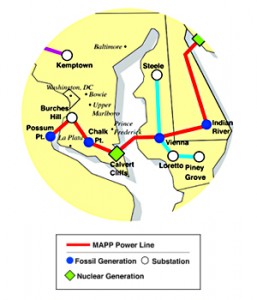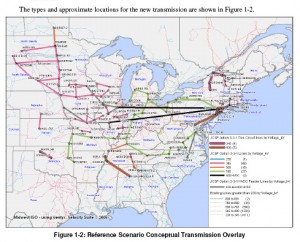PJM shell game continues
October 14th, 2010
This week, PJM has “decided” that part of the humongous 500kV buildout isn’t necessary. Well DUH, but…
PJM Press Release – PJM Board authorizes $18 billion in transmission upgrades
And so please explain why the headline isn’t “PJM Board cancels 500-kilovolt (kV) line connecting the Branchburg, Roseland and Hudson substations in northern New Jersey.”
From that PJM board meeting, there was a presentation that looks like a corporate-style WAKE UP call:
Meanwhile, I’m trying to find the primary documentation, something with specifics about what was “approved” and what was “removed” and the basis for it… nada… nothing that I can find on the site. Something else irritating is that when I’m looking up documents on the PJM site, I often just get a blank black page, particularly from the TEAC site.
One interesting presentation was about a Market Efficiency Analysis, in 2014 without Mid-Atlantic Power Pathway (MAPP), Potomac-Appalachian Transmission Highline (PATH), Branchburg-Roseland-Hudson and Susquehanna-Roseland, and from then on without the Branchburg, Roseland and Hudson line:
2010 Market Efficiency Analysis Results Updates – October 6, 2010
And when I try to get closer to the Northern NJ documentation… well, tell me if YOU can get anything:
“File is damaged and could not be repaired.” So I called the number on the PJM press release to see… and was told they’ll call back. Yes, we shall see…
PJM & PEPCO’s MAPP line trying to appease
May 9th, 2010
The MAPP line, PEPCO’s Mid-Atlantic Power Pathway transmission line project through Maryland and Delaware, is in the news again. But why??? Where the line is not needed, and it’s withdrawn by PJM and PEPCO, why is this being accepted? Why is this regarded as a “win?”
Remember that they pulled the project?
PEPCO letter 1.8.09 to suspend MAPP, includes 1.8.09 letter from PJM’s Herling
And before that, the part from Indian River to Salem was eliminated?
The May, 2009, Press Release says:
According to Gausman, PJM has also reviewed the need for the section of the line that would run from Delmarva Power’s Indian River substation near Millsboro, Del., to Salem, N.J., and has decided to move this portion of the line into its “continuing study” category. This means that the reconfigured MAPP line will now extend approximately 150 miles from northern Virginia, across southern Maryland and the Chesapeake Bay, and terminate at Indian River. The change would likely reduce the total project cost from $1.4 billion to $1.2 billion.
And then there’s the report that shows there’s no need, that demand is downdowndown, that “congestion” is downdowndown, that price of electricity is downdowndown, that demonstrates that the market concept that they’re all drooling over will have them aspirating their aspirations:
So then why did they send out a press release last week:
…which every Peninsula news outlet gave pretty much verbatim coverage?
And then there’s the PJM RTEP 2009, released February 26, 2010.
So here’s how their press release looks after the papers get it:
Delaware utilities: Plan takes power line under Choptank
It is being planned by Pepco Holdings Inc., parent company of Delmarva.
Now read the other “articles” and tell me if there’s an echo in the room:
Underwater power line route suggested
Proposal under Chesapeake avoids refuge
By Calum McKinney • Staff Writer • May 6, 2010
But the day before it was better, with some original quotes:
Monitoring Analytics’ PJM State of Market for 2009
March 12th, 2010
At last, the report we’ve all been waiting for! TAA-DAAAA:
Don’t worry, I can FEEL you all rolling your eyes, just suspend disbelief and read this thing. If nothing else, just look at the pictures!
And if you want to download it, well, pour a cup of coffee, and maybe pack a lunch, it’s a big report with lots of graphics that takes a while. But it’s well worth it…
National Park Service extends Comment period
March 5th, 2010
National Park Service has extended the deadline for EIS Scoping Comments on the Susquehanna-Roseland transmission project. WHEW! Now we have until March 12 to send our comments in!
Get your clues on Comments from what they do and do not include:
It’s in the Pocono Times:
From the NPS blog:
Posted March 5th, 2010 by Kurt Repanshek
High public interest has prompted the superintendents of Delaware Water Gap National Recreation Area, the Appalachian National Scenic Trail, and the Middle Delaware National Scenic and Recreational River and National Recreation Water Trail to extend by a week the public comment period on a proposal to run a transmission line across the areas.
The comment period was scheduled to end today, but has been extended through March 12.
There are numerous ways for the public to provide comments on the public scoping phase of the planning process, including leaving a message on the Park Planning Information Telephone Line (570-426-2491), submitting comments online through a link on the National Park Service Planning, Environment and Public Comment site, http://parkplanning.nps.gov (select Appalachian NST or Delaware Water Gap NRA), or by mailing comments to:
Detailed information about the need for the EIS and the project timeline
can be found on the National Park Service Planning, Environment and Public
Comment site: http://parkplanning.nps.gov.
DUH… eastern states don’t want our transmission
March 5th, 2010
Repeat after me… EASTERN STATES DON’T WANT OUR MIDWEST TRANSMISSION.
Once more with feeling… EASTERN STATES DON’T WANT OUR MIDWEST TRANSMISSION!!!
And they don’t give a rodent’s rump what we do with our transmission but THEY DO NOT WANT TO PAY FOR IT!
It’s not anything new, but it seems that the message is getting through all the way to Iowa. Soon Minnesota? The message? That the east coast does not want Midwest transmission, that they have their own renewables and not only that, they know that transmission from the Midwest means coal and, most importantly, THEY WILL NOT PAY FOR TRANSMISSION FOISTED UPON THEM.
The 7th Circuit case tossing out PJM’s cost apportionment scheme must be having an impact because everyone is freakin’ about cost allocation. Again, GOOD! The court said that PJM could not shove the costs of transmission on those who do not benefit from it:
Enter the Coalition for Fair Transmission Policy, just launched today with a press conference in Washington, D.C.
Dig this from their site:
HA! I love it when that happens…
Here’s some background on our Midwest Transmission — transmission we don’t need and they don’t want:
This opposition to Midwest transmission is nothing new, I’ve entered documentation in the record in a couple of proceedings now, but what is new is that as of today’s “launch,” there’s now an industry group advocating against Midwest transmission, and that’s one utility interest I’m glad to see hopping mad as hell and not going to take it anymore! GOOD! Maybe that will help stop this stupid transmission-fest across the Midwest.
PUC Chair David Boyd had it right when he testified before Minnesota’s Legislative Energy Commission and led off with, “We need a business plan.” Yes, that’s true, there is no business plan, and there is no MARKET for transmission. I just hope that message gets through before “we” build and WE have to pay for all these wires in the air!
Here are a few recent posts of mine on this, followed by today’s article in the Des Moines Register.
And today’s Des Moines Register article:
By DAN PILLER • dpiller@dmreg.com • March 5, 2010
Alliant Energy has its objections
But as wind energy becomes bigger and more corporate, the utility industry is divided even in Iowa.
Other states have their own plans
While Iowa has speckled its countryside with wind turbines, other states have similar aspirations.
Atlantic seaboard states advanced plans for offshore wind farms, which they say would eliminate the need to ship wind-generated electricity from Iowa.
Read the rest of this entry »




